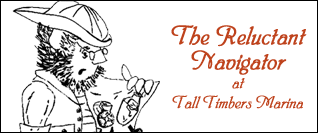NAVAIR PATUXENT RIVER, MD—A combined Navy, industry and academia team received the 2002 DoD Value Engineering Award June 18 at the Pentagon for their tactical acoustic measurement and decision aid sonobuoy system, known as TAMDA.
The project was initiated in 1998 to solve the problem of where to place tactical sonobuoys in the water, particularly in shallow-water operating areas.
“With sonobuoy costs ranging from $250 to $5,000, you could waste a lot of money if they’re not placed correctly,” said Dan Flynn, TAMDA integrated program team leader.
The Avionics Department went “shopping for technology” among completed NAVAIR Small Business Innovation Research contracts. They found some good matches.
The small companies that eventually signed on were Navmar Applied Sciences, Applied Hydro-Acoustics Research, and Phoenix Science and Technology. Each company had proved its mettle by transitioning technologies to commercialization of their product. Additional partners included Space and Naval War Systems Command, Naval Sea Systems Command and the University of Washington.
The TAMDA team eventually built a new sonobuoy using the SBIR technology along with parts from existing fleet buoys. An underwater microphone, or hydrophone, was borrowed from the AN/SSQ-53F sonobuoy, and a water column temperature sensor from the AN/SSQ-36 sonobuoy.
“The SBIR innovations were the glue that pulled everything together and allowed us to shrink the technology down into one buoy,” Flynn said. “We also made it modular so we could take things out and put other things in, always keeping in mind our maximum allowable weight of 39 pounds.”
The team tested the new sonobouy in the Gulf of Mexico in April. NAVAIR 38, a converted offshore support vessel modified to accommodate advanced research projects, was pressed into service. Trailer laboratories were transported from Patuxent River and set up in the back of the boat.
The team had to generate sound to probe the ocean bottom. In addition to the buoy’s design architecture, Navmar created sound waves by crushing Christmas balls and light bulbs in the water to probe the ocean bottom. The pressure of the ocean holds the ball intact until it drops a few hundred feet, where it breaks, creating a loud noise the sonobuoy can then measure.
Phoenix came up with a competing sound source using an electrical circuit similar to a spark plug. The spark creates a gas bubble, which when collapsed by the ocean pressure, also creates a loud noise.
Applied Hydro-Acoustic Research is developing the system that processes the buoy’s data. The design architecture consists of ingesting buoy data and merging it with historical climatologic ocean data into a spatially and temporally variant ocean model. This model can then be used by air ASW decision aid systems in a manner that is tactically relevant.
The University of Washington verified the operational concepts of the buoy, data collection, and bottom parameter calculations made on site.
“We tested the data transmission by sending it via a small satellite telephone in the sonobuoy to the university labs in Seattle,” Flynn said. “You can take these telephones anywhere, and just make a regular call to get the data from the buoy.”
The ultimate goal is to send data back to NAVOCEANO databases and to the tactical environmental data server at SPAWAR.
TAMDA will provide previously unavailable data on sound waves interacting with the bottom of the ocean. Real-time measurement of ocean sound speed, ambient noise, reverberation and water depth provides critical data to an air ASW mission, particularly in shallow-water operating areas.
“These measurements are important because they allow us to optimize the placement of the sonobuoys,” Flynn said. “The primary things we need to find out are the temperature of the water, the sounds in the ocean, how sound bounces from the bottom to the surface. In the ocean, the sounds are absorbed, reflected or scattered, depending on the makeup of the bottom, whether it’s mud, sand, rock or corals.”
One TAMDA goal is to eliminate explosives in the water and the need for a P-3 aircraft to fly around and constantly collect measurement data. The new sonobuoy can be left in the ocean for unattended measurements, allowing any aircraft or ship to tap into the data as needed. This contributes to efficient net-centric operations, curbs the amount of noise in the water, and leaves the habitats of ocean mammals undisturbed.
The new sonobuoy will do the job, in a single buoy, that currently requires six buoys.
“I nominated the TAMDA team for the DoD award because their work fit the criteria of yielding value engineering savings,” Signal Processing branch head Dr. Mary Eileen Farrell said. “Not only will TAMDA reduce the number of sonobuoys that need to be deployed, but it will help with environmental impacts.”
TAMDA, now in the concept exploration phase, is on target to meet milestone B by the end of fiscal year 2005. The new technology will primarily enhance P-3 and MH-60 operations, but is a net-centric, platform-independent system that can be connected to other ASW units for immediate use.


